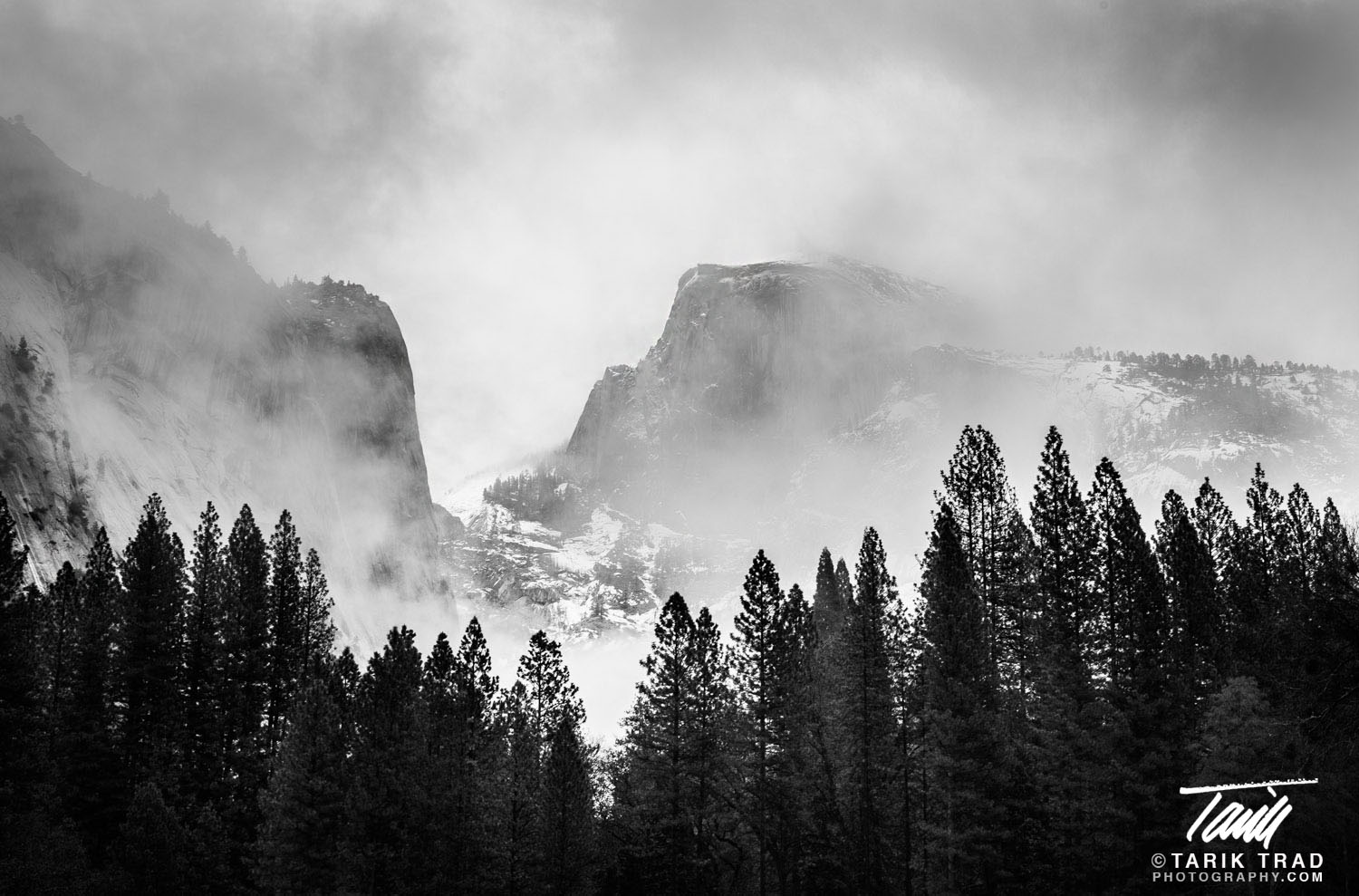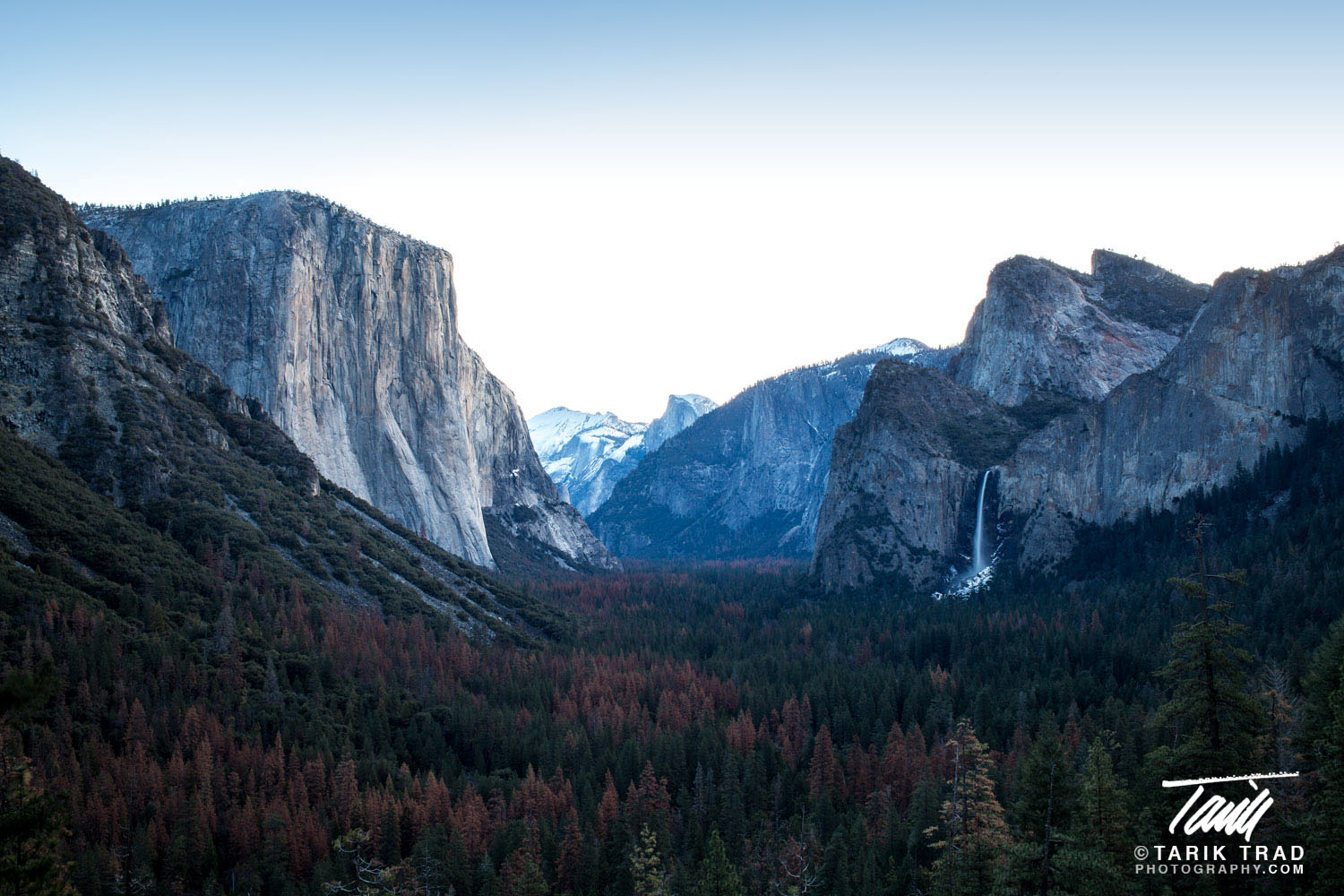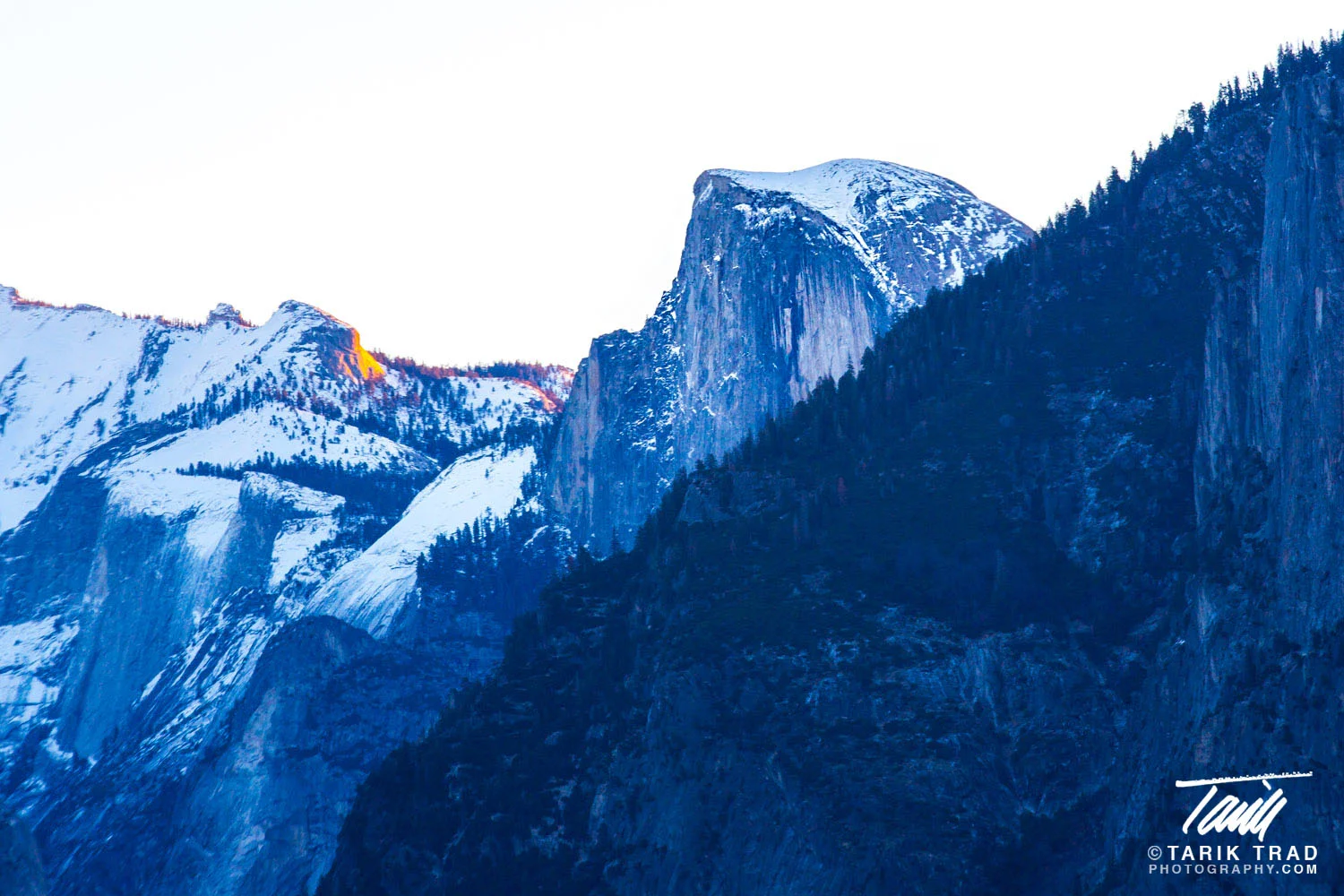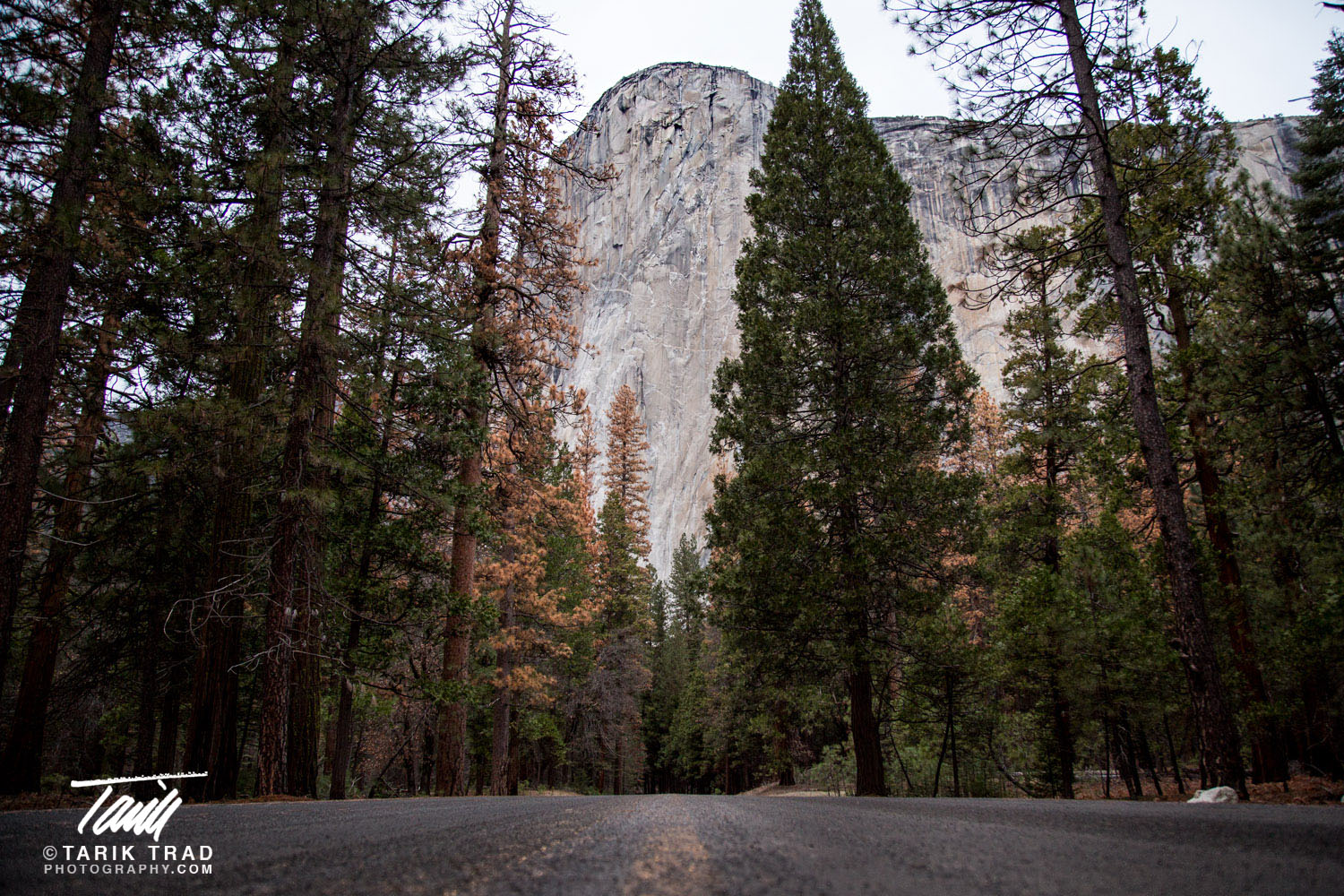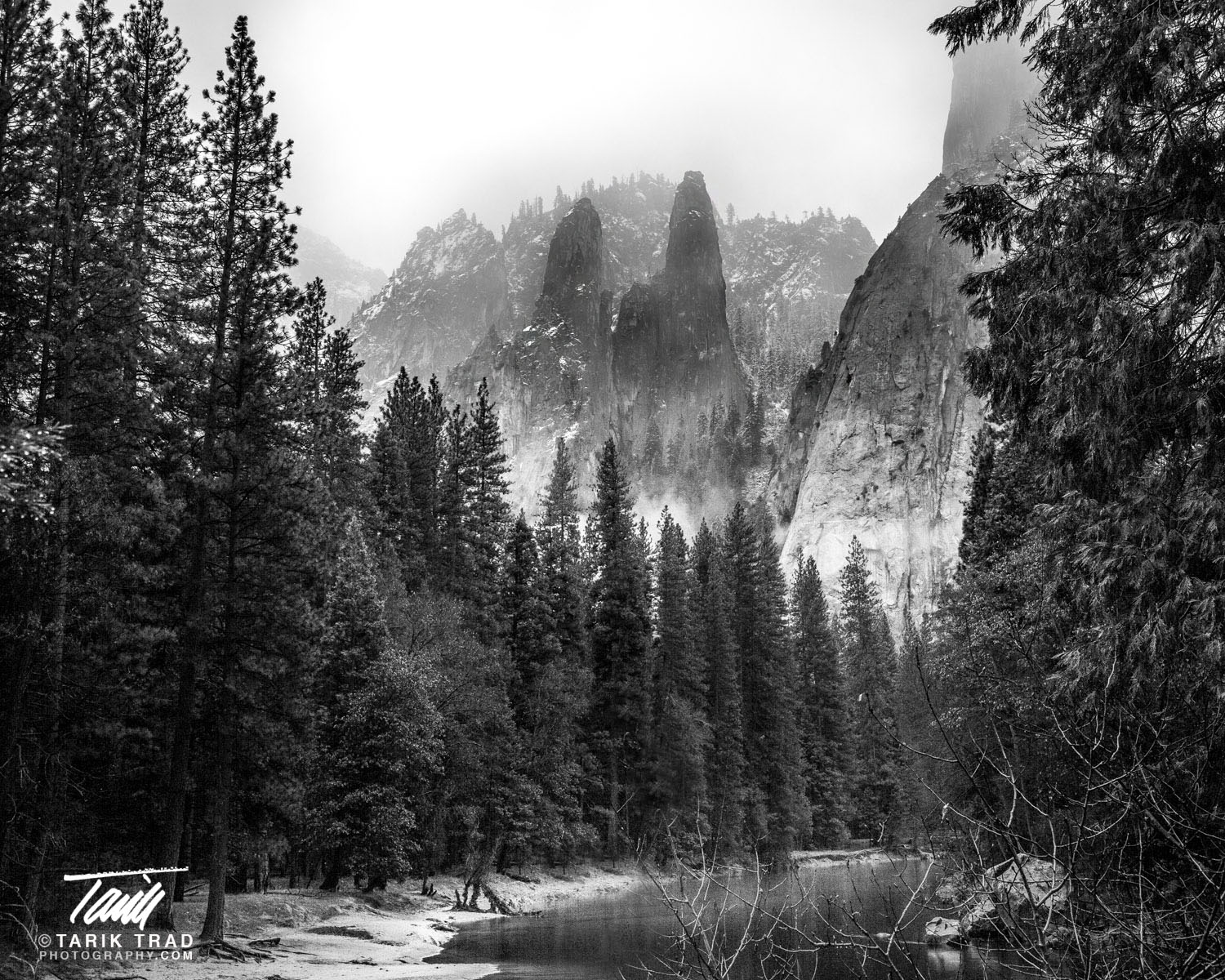Yosemite National Park in the Sierra Nevada mountain range is one of the most beautiful and, not coincidentally, most photographed places on earth.
Footsteps in the Snow. Photo from my previous visit to Yosemite in December 2010. Click to view larger image.
While the park is more than 1,200 square miles of trails, mountains and wilderness, the vast majority of visitors spend their time in Yosemite Valley, home to some of the highest, largest and most uniquely glacier-carved granite canyon walls in the world – such as El Capitan and Half Dome – as well as an abundance of water falls, including Yosemite Falls, the highest waterfall in North America.
The Park has always held a close place in my heart. My family often visited during the summers of my childhood. I was also lucky enough to spend a summer in the Park as a volunteer backcountry ranger upon graduating from college. In addition, I fell in love with the photography of Ansel Adams, to the point where it inspired me to continue on with photography for most of my youth and adult life. To this day, Yosemite still takes my breath away.
It had been a few years since I visited the Park, so I decided that a December trip – just me and my camera – was much overdue.
Winter is a special time in Yosemite. Though much of the beauty of the park is inaccessible by car – such as Tuolumne Meadows and Tenaya Lake – the crowds are a mere fraction of what they are during the summer months. Being by myself, I knew that I had a lot of flexibility in shooting what I wanted as long as I stayed close to Yosemite Valley. However, with the shortest days of the year in late December, I had to put together a schedule of what and where I wanted to shoot – and stick to it.
Weather Conditions
As anyone with experience visiting the area knows, the weather conditions any time of the year in the Sierras can turn at a moment's notice, so it's important to keep an eye on the news. The first day's forecast (Thursday, December 22) was to be cold and clear. The second day (Friday, December 23) was predicted to have snow in the morning with freezing rain later in the day. My plan was this: With my window of opportunity less than two full days, and with it being a six-hour drive from Los Angeles to Yosemite Valley, I would drive up Wednesday afternoon and spend the night with my in-laws in Fresno (two hours from the Park), arrive ready to shoot no later than 6:30 a.m. on Thursday (sunrise was at 7:10 a.m.), spend the night in the Park at one of the heated cabins, then leave no later than 2pm on Friday to be completely out of the mountains by sundown.
As expected, the drive to the Park was non-eventful. While it was a bit cold (19 degrees when I arrived at my first destination), there was very little traffic at that hour and the road conditions in the Park were good.
I know some of you are thinking: Why in the heck are you getting there so early in the morning and driving so far just to take photos in the cold? In the world of photography, if you snooze, you lose. Many photographers know the best time to take pictures is during what is referred to as the “magic” hour, the period shortly before and after sunrise and sunset during which daylight is softer than when the sun is higher up in the sky. It is also very mentally therapeutic. If you want the opportunity to take great photos, you must endure some great discomfort, such as loss of sleep, long-distance drives, deal with the harsh elements of nature, and wait and wait and wait. The end results typically make the journey worth the effort and turns the trip into a story.
Day One: Tunnel View / Gates of the Valley
The first stop on my schedule was what typically is the first real view of Yosemite visitors get of the Park – the Tunnel View. The Tunnel View gets its name as literally the first turnout once you complete a mile-long drive through a tunnel carved into the granite hillside. It is quite an unexpected and stunning view – particularly when you consider you just drove the past hour or two through tree-lined, winding mountain roads to get to this point.
Gates of the Valley, with El Capitan on the left, Half Dome in the center, and Bridalveil Fall to the right. Click to view larger image.
Once you enter the lot, it's like you just landed on a different planet. It's really quite jarring to your psyche. As soon as you step out of the car, your immediate view – also known as the Gates of the Valley – is as crisp and clean as the mountain air. Right in front of you stands what many have described as God's Fingerprints – a sweeping mountain valley – to your left stands El Capitan, rising nearly 3/4 of a mile straight up from the Valley floor, the largest granite monolith in the world. In the middle stands Half Dome, the iconic granite dome at the far end of Yosemite Valley named for its distinct shape, carved by a glacier from the last ice age 18,000 years ago. To your right is Bridalveil Fall, one of the most prominent and unobscured waterfalls in Yosemite Valley, topped by Cathedral Rocks above the fall.
In the summer, the parking lots on both sides of the road at the Tunnel View are packed and the sidewalks lined with photographers and their tripods. This is the first stop for the many tour buses that frequent the Park. The "nature" experience of the visit can be jaded a bit with all the cars, noise, and people. When I worked the summer in the Park, we used to joke that Yosemite is where EVERYONE went to get away from it all.
When I arrived, there were maybe five or six cars in the lot. After all, the sun wasn't supposed to rise for another 40 minutes and its rays wouldn't reach the Valley's canyon walls for at least another 20 minutes after that. However, from each of the cars were quite a few photographers and videographers already lined up, preparing to capture the moment in front of them. So, I joined the queue and took in the view.
“Remember: This is a National Park – spelled W-I-L-D-E-R-N-E-S-S with a capital W – and with night comes nocturnal wildlife in their natural habitat. I’m sure they’re just as scared of me as I am of them (or so we’re told), but they have the home-field advantage – and they can see me!”
I set up my camera on the tripod and took a few test shots. It's interesting what your camera can catch what your naked eyes don't see, and vice versa. While my eyes could make out much of Valley's details in the early dawn light, my underexposed camera caught a distinct silhouette of the Gates of the Valley. The image can be found below in the complete set – photo number one. Personally, it might be my favorite shot of the entire trip.
As I properly adjusted the camera's exposure levels, the light of the magic hour was doing its job. The one issue that would affect nearly all my Day One photos were the lack of clouds. I know this might sound odd, but having clouds or mist or fog in the sky can produce a very unique and dramatic photograph – clouds add character and can make all the difference in a landscape photo. Without them, the shot – while still quite beautiful – would appear uninteresting. However, I do not control the weather and cannot wait around in the Park for a week, so I continued to do my job and hoped for the best. Besides, I would rather be here than just about anywhere else.
I spent nearly an hour at the Tunnel View, long enough to see a glimpse of sunlight peak through and and kiss the exposed granite on the nearly snow-covered Clouds Rest just beyond Half Dome in the backcountry. It is this fiery glow – often seen just after sunrise and just before sunset – that makes Yosemite even more special. It is an inspiring yet fleeting site. So I must move on.
Half Dome at sunrise with the first rays of the day striking Clouds Rest to the east.
Bridalveil Fall
My first stop after the Tunnel View was Bridalveil Fall. There are numerous places to take photos of this elegant waterfall, but I wanted to get an up-close shot, so I drove to the viewpoint, parked the car and hiked right up to the base of the fall. In the winter, the south end of the Valley doesn't see a lot of direct sunlight. Since I arrived at this spot shortly after sunrise, the mist from the falls during the evening spread a thick blanket of ice across the entire trail. Even with park rangers utilizing de-icing measures, you had to pay close attention to every step, especially at the base. There would be no off-trail photos at this stop. It was almost like ice skating. Not good.
Long exposure of Bridalveil Creek just below Bridalveil Fall. Click to view larger image.
One of the goals of this trip was to get some experience using longer exposures to get a "silky" effect on certain parts of my subjects, whether it be a waterfall, a stream or the clouds. This is accomplished by setting your camera on a tripod, adding a neutral density (ND) filter to my lens, setting an exposure of one second or longer, then releasing the shutter with a remote rather than using my finger (to eliminate any shaking). When done correctly, the objects that are moving in your shot give a glowing or silky appearance while the stationary objects appear normal without being overexposed. You will see this in a few of my photos on this trip, particularly from the Tunnel View and several from Yosemite and Bridalveil Falls. In few cases, I am happy with the results.
Yosemite Falls
Next stop on my schedule was El Capitan. Unfortunately, I was not able to properly capture it on my camera at this point of the trip. Not that it's hard to miss, mind you. In fact, you can see it from almost any point in the Valley. I just felt the photos I took did not do it justice. So, I moved on to my next subject, Yosemite Falls.
You'll notice it's called "Falls" and not "Fall" as is Bridalveil. That is because Yosemite Falls is actually categorized into three sections – the upper, middle and lower falls – dropping a total of 2,425 feet from the top of the upper fall to the base of the lower fall. It is the highest waterfall in the Park and, when combining the three drops, is the highest waterfall in North America.
Wide view of Yosemite Falls taken from Sentinel and Cook's Meadow near Swinging Bridge.
At this point, since the weather was cool and clear, I decided to park the car, gather my camera backpack, water and energy bars, and took a hike through the Valley for the rest of the morning and early afternoon.
“If you want the opportunity to take great photos, you must endure some great discomfort, such as loss of sleep, long-distance drives, deal with the often harsh elements of nature, and wait and wait and wait. The end results typically make the journey worth the effort – and turns the trip into a story.”
Swinging Bridge
The Swinging Bridge is a great spot to take photos of Yosemite Falls. It is called the "swinging" bridge as it goes to both sides of the Merced River, the main river in the Valley. When I got there, it was still in shadows and had a thin layer of frost on the bridge and its railings. You'll see in the photo below the frost reflected the blue skies from above, giving the illusion that the bridge was iced over like a glacier.
At this point, I had the choice to continue over the bridge or to step out into Sentinel and Cook's Meadow under Yosemite Falls and the eastern end of the Valley. I would later regret this decision as continuing over the bridge would have taken me to the trailhead that leads to the middle falls. Normally, I would just drive to that area but, unbeknownst to me, road closures in the park (and weather conditions the following day) would make driving or hiking to this section impossible.
Rainbow at the base of the upper section of Yosemite Falls. Click to view larger image.
Luckily, I brought along a long telephoto lens which allowed me to capture some details of Yosemite Falls that I wouldn't normally get to see, including a rainbow that occurs when the falling water retracts off an ice dome that forms at the base of the upper falls during the winter.
Later that afternoon, I stopped for lunch in Half Dome Village (formerly Curry Village), then went for another hike toward Mirror Lake. On my way, I walked through a forested campsite that was closed for the winter. Later, I came across an old bridge that you can either walk over or under. As I started to walk under the bridge, I startled a bobcat on the other side. Not sure who was more startled as I failed to take a picture of my furry friend before he scampered off to find his own lunch.
half dome
I was trying to keep a close eye on the time as my original plans were to drive back to the Tunnel View to get a shot of the fiery sunset on the granite cliffs of El Capitan. Because of my long walk through the forested campground and the shadowed trail toward Mirror Lake, I failed to notice that while technically there was still an hour of daylight left before sunset, the sunlight was quickly leaving the Valley floor.
Unfortunately, my car was parked more than a mile away at the Swinging Bridge, so a sunset shot from the Tunnel View was out of the question. I did manage to hike back to Cook's Meadow just before the last light of the day hit the side of Yosemite Falls. Better yet, as I turned to look east, I got the surprise of my life to see the face of Half Dome engulfed in the sun's setting rays. All I could do was stand there and stare at such a magnificent site until the sun finally set and evening enveloped Yosemite Valley.
After the sun was set, the Valley got dark and cold quite quickly. So, I made a beeline for my car and headed back to Half Dome Village where I checked into my cabin and had a light dinner. I still had photo plans that evening, but I had to wait until the twilight was completely gone. I got to my cabin, set my alarm for two hours, and fell quickly and deeply asleep in my warm bed.
Yosemite Valley and the Milky Way
Thursday night was a moonless night, so the Valley was extremely dark with one exception – the stars. Even though I spent a summer as a backcountry ranger, I forgot just how blissful the absolute quiet, darkness, and a piercing night sky can be. For those of us that live in an urban or suburban setting, we have no idea what we're missing from all the light noise caused by city lights.
Yosemite Falls and the Milky Way. Click to view large image.
My intention was to take shots of the Milky Way from a few points in the Valley. Even in winter, when most of the Milky Way appears in the Southern Hemisphere, there is still a good portion of it that can be seen looking north. Heck, you can see it with your own eyes once they adjust to the darkness.
Photographing the Milky Way is not too difficult if you know what you're doing. Unfortunately, I didn't have the patience to do this correctly. It was one of the few times during this trip where I could have used some human companionship. I went to three different locations – Tunnel View, El Capitan, and the meadow across from Yosemite Falls. Each time, I was spooked more than a bit by the cold and the darkness. Remember: This is a National Park – spelled W-I-L-D-E-R-N-E-S-S with a capital W – and with night comes nocturnal wildlife in their natural habitat. I'm sure they're just as scared of me as I am of them (or so we're told), but they have the home-field advantage – and they can see me!
With my anxiety levels on high, I rushed through each of the steps required to get the shots I wanted, and it showed in my results. Fail. Next time, I plan to bring the right equipment (a wider lens with a lower f/stop) and a fellow human photographer/assistant/friend/protector from the creatures to join me.
I headed for bed as another early morning (and a few surprises) awaited me.
DAY TWO: WHAT A DIFFERENCE A FEW CLOUDS MAKE
On Friday morning, I left the cabin at 6 a.m. to drive back to the Tunnel View. It was dark and cold (18 degrees), and the forecast had changed from snow to rain in the morning to blizzard conditions and freezing rain later in the afternoon. The plan was now to take as many shots from as many different areas as I could until the weather told me otherwise.
It was a good two hours.
I arrived at the Tunnel View. Again, there were about a dozen folks with tripods and cameras catching the view. There were some clouds but the view was mostly the same as the day before, so I decided I'd seen enough and went back down to they Valley. It was the right decision because fog and mist started to roll in, making for some very special shots. I was able to get some very intense photos of Bridalveil Fall, Yosemite Falls, Half Dome, even one of El Capitan.
Click on the first image to start a slideshow. You can advance to the next photo by clicking the arrow on your computer or wiping with your finger on a smartphone or tablet. Press the ESC key to get out of slideshow mode.
After about two hours, the skies opened up and the rain fell. Not sure how it wasn't snowing (it was still bitterly cold) but the rain insisted on nearly flooding parts of the Valley. I had to checkout by 11 a.m., so I went to get some breakfast and coffee and waited it out (I wasn't going to risk ruining my equipment). Finally, after checking out and packing the car, I sent a text to my wife to let her know that I would be leaving early if the rain kept up.
Know When to fold 'em
By noon, I had enough of the rain. I knew if it was raining in Yosemite Valley at 4,000 feet, the mountain passes would be getting at least a wintry mix of rain, snow and ice. It was time to go.
On my way out of the Park, I decided to take one last chance and see what was happening at the Tunnel View. It was on the way out of the park and would give me an opportunity to stop and put tire chains on the car should the view be washed out. I was glad I stopped.
The mist and fog in the Valley below was creating a scene I could only dream of. There was a light snow beginning to fall – not enough to stop me but enough to put a plastic cover on the camera. As I fired shot after shot after shot, I was completely mesmerized by the view of the storm passing through Yosemite Valley. I looked over the guy taking pictures next to me. We both knew what we were witnessing. Before I could say anything, Jordan introduced himself and said, "I've been coming here with my camera four times a year for as long as I can remember and this is the first time I ever seen anything like this."
I nodded in agreement and turned away before Jordan could catch the tears of wonder and joy filling my eyes. I think he was doing the same.
It was a moment we'll never forget.
Gates of the Valley, Yosemite National Park.
# # #
Special thanks to my mother and father-in-law for their love and graciousness.
Thanks to my wife and family for understanding the need for this trip was much more than the want.
Thanks to Photographer Michael Frye for his tips and his Photographer’s Guide to Yosemite iOS App. Can't wait to use it again.
Thanks to the Creator of all things – seen and unseen – for the beauty He shares with us in this world and the Next. I am truly grateful.
Below you will find a complete set of photos from my recent trip to Yosemite in chronological order. Click on the first image of the set to start a slideshow. You can advance to the next photo by clicking the arrow on your computer or wiping with your finger on a smartphone or tablet. Press the ESC key to get out of slideshow mode. Most of these images are available to purchase as custom prints. Contact me for details.



